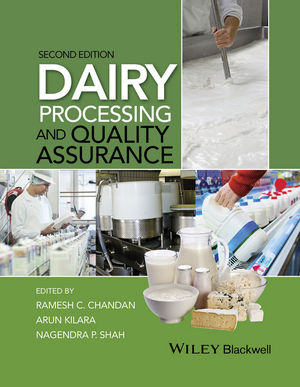Good dairy products start with good milk
Dairy processing plants must run a battery of tests on raw milk. Later, the lab checks out finished products. In this article, a lab evaluation officer from the state of South Dakota reviews the tests and the testing methods.


Milk has the distinction of being nature’s most perfect food and is also the most widely tested food on the dinner table. This nutrient-packed and perishable food requires substantial controls and testing to assure the consumer of enjoying a safe and highly nutritious food.
The United States Public Health Service/Food and Drug Administration in cooperation with the states’ agriculture and health departments, along with dairy producers and processors, developed the Grade A Pasteurized Milk Ordinance (PMO). The Grade A PMO is recognized by the public health agencies and the dairy industry as the national standard for milk sanitation. It contains all the public health standards for Grade A milk and milk products such as fluid beverage milk, dried milk, cream, yogurt, buttermilk, cottage cheese and sour cream.
In conjunction with the public health standards of the Grade A PMO, the Code of Federal Regulations (CFR) 21 part 131 contains the standards of identity for Grade A milk and milk products. The CFR combined with the Grade A PMO contains the Grade A milk and milk products standards for the dairy industry. The dairy industry may implement more stringent demands as long as they meet the requirements found in the Grade A PMO and 21 CFR 131.
It is a commonly known fact that the ultimate quality of the final food product is determined by the raw ingredients making up the particular food product. Therefore, we would be amiss if we did not start our journey of dairy laboratory testing with the raw milk. Starting from the time the raw milk is received at the processing plant; milk begins its testing journey on the way to the consumer’s dinner table.
One of the important public health standards that must be met is determining that the raw milk is antibiotic-free. At a minimum, all raw milk must be tested for antibiotics prior to processing. The testing laboratories are certified by the appropriate state regulatory agency while the various antibiotic test kits are validated for use by the United States Food and Drug Administration-Center for Veterinarian Medicine (USFDA-CVM).
In the event that antibiotics are found in the raw milk, this adulterated milk is disposed of in a manner that removes it from the human food chain as outlined in the Grade A PMO Appendix N. Raw milk is also required to be analyzed for direct microscopic somatic cell count, total bacteria count, and temperature. All raw milk must meet the bacteria standard not to exceed 300,000 per milliliter comingled, somatic cell count standard not to exceed 750,000 per milliliter, and temperature standard of 45˚F or less.
Optional tests that the dairy industry may conduct on the raw milk include titratable acidity, pH, direct microscopic count-bacteria, added water, and components (butterfat, protein). All these tests assure the processor of receiving the best-quality raw milk supply possible.
Traveling down the dairy processing road from the raw milk we now stop at the finished product testing. The Grade A PMO requires testing the finished Grade A milk and milk products for total bacteria count, coliform, phosphatase and antibiotics. The test results of these products must not exceed 20,000 per milliliter total bacteria count for non-cultured products and no more than 10 coliforms per milliliter. In addition, these products must test negative for antibiotics and phosphatase as outlined in the Grade A PMO. Products failing to meet the standards are removed from the human food chain. The standards of identity found in 21 CFR 131 for each individual milk and milk product must also be met in terms of total solids/moisture, butterfat, and titratable acidity if applicable.
Now that we have touched on the highlights of the dairy laboratory testing for Grade A milk and milk products, we need to determine which testing methods to employ. There are numerous antibiotic test kits available to use with new ones being developed as the need arises. These test kits are split into two categories; one for testing raw milk and one for testing finished products.
Moving onto the microbiological testing; the old reliable poured agar methods for bacteria are still used but newer more convenient methods have been developed. Currently, only the poured agar methods and a film method are approved for use under the Grade A PMO for regulatory testing. However, industry laboratories are not tied to these constraints since they are not reporting regulatory results.
Another important public health standard for finished milk and milk products is the phosphatase test. Phosphatase testing assures the dairy industry and ultimately the consumer that the milk and milk product was properly pasteurized to destroy all milk-borne disease organisms and pathogens.
The dairy industry’s two options for determining component values (butterfat, protein, total solids) in the milk and milk products include the standard wet chemistry methods or the mid-infrared spectroscopy instruments. Taking a closer look at the wet chemistry methods for butterfat, we find the Gerber, Babcock, Mojonnier, and Roese-Gottlieb methods.
As most students taking a dairy foods laboratory course have learned, the Babcock butterfat method is unarguably the most widely known method for determining butterfat. The Kjeldahl method is the old stand-by when it comes to determining milk protein while total solids/moisture can be determined using the force-air oven method. These methods require a trained analyst and a substantial amount of time to generate the butterfat, protein and total solid values.
Today’s dairy laboratories need to provide milk component results in short order to the dairy processing departments. Therefore, mid-infrared spectroscopy instruments have widely replaced the wet chemistry methods in the dairy laboratories. These instruments must be calibrated with known standards which are determined using the previously mentioned wet chemistry methods.
Beginning witMilk has the distinction of being nature’s most perfect food and is also the most widely tested food on the dinner table. This nutrient-packed and perishable food requires substantial controls and testing to assure the consumer of enjoying a safe and highly nutritious food.
The United States Public Health Service/Food and Drug Administration in cooperation with the states’ agriculture and health departments, along with dairy producers and processors, developed the Grade A Pasteurized Milk Ordinance (PMO). The Grade A PMO is recognized by the public health agencies and the dairy industry as the national standard for milk sanitation. It contains all the public health standards for Grade A milk and milk products such as fluid beverage milk, dried milk, cream, yogurt, buttermilk, cottage cheese and sour cream.
In conjunction with the public health standards of the Grade A PMO, the Code of Federal Regulations (CFR) 21 part 131 contains the standards of identity for Grade A milk and milk products. The CFR combined with the Grade A PMO contains the Grade A milk and milk products standards for the dairy industry. The dairy industry may implement more stringent demands as long as they meet the requirements found in the Grade A PMO and 21 CFR 131.
It is a commonly known fact that the ultimate quality of the final food product is determined by the raw ingredients making up the particular food product. Therefore, we would be amiss if we did not start our journey of dairy laboratory testing with the raw milk. Starting from the time the raw milk is received at the processing plant; milk begins its testing journey on the way to the consumer’s dinner table.
One of the important public health standards that must be met is determining that the raw milk is antibiotic-free. At a minimum, all raw milk must be tested for antibiotics prior to processing. The testing laboratories are certified by the appropriate state regulatory agency while the various antibiotic test kits are validated for use by the United States Food and Drug Administration-Center for Veterinarian Medicine (USFDA-CVM).
In the event that antibiotics are found in the raw milk, this adulterated milk is disposed of in a manner that removes it from the human food chain as outlined in the Grade A PMO Appendix N. Raw milk is also required to be analyzed for direct microscopic somatic cell count, total bacteria count, and temperature. All raw milk must meet the bacteria standard not to exceed 300,000 per milliliter comingled, somatic cell count standard not to exceed 750,000 per milliliter, and temperature standard of 45˚F or less.
Optional tests that the dairy industry may conduct on the raw milk include titratable acidity, pH, direct microscopic count-bacteria, added water, and components (butterfat, protein). All these tests assure the processor of receiving the best-quality raw milk supply possible.
Traveling down the dairy processing road from the raw milk we now stop at the finished product testing. The Grade A PMO requires testing the finished Grade A milk and milk products for total bacteria count, coliform, phosphatase and antibiotics. The test results of these products must not exceed 20,000 per milliliter total bacteria count for non-cultured products and no more than 10 coliforms per milliliter. In addition, these products must test negative for antibiotics and phosphatase as outlined in the Grade A PMO. Products failing to meet the standards are removed from the human food chain. The standards of identity found in 21 CFR 131 for each individual milk and milk product must also be met in terms of total solids/moisture, butterfat, and titratable acidity if applicable.
Now that we have touched on the highlights of the dairy laboratory testing for Grade A milk and milk products, we need to determine which testing methods to employ. There are numerous antibiotic test kits available to use with new ones being developed as the need arises. These test kits are split into two categories; one for testing raw milk and one for testing finished products.
Moving onto the microbiological testing; the old reliable poured agar methods for bacteria are still used but newer more convenient methods have been developed. Currently, only the poured agar methods and a film method are approved for use under the Grade A PMO for regulatory testing. However, industry laboratories are not tied to these constraints since they are not reporting regulatory results.
Another important public health standard for finished milk and milk products is the phosphatase test. Phosphatase testing assures the dairy industry and ultimately the consumer that the milk and milk product was properly pasteurized to destroy all milk-borne disease organisms and pathogens.
The dairy industry’s two options for determining component values (butterfat, protein, total solids) in the milk and milk products include the standard wet chemistry methods or the mid-infrared spectroscopy instruments. Taking a closer look at the wet chemistry methods for butterfat, we find the Gerber, Babcock, Mojonnier, and Roese-Gottlieb methods.
As most students taking a dairy foods laboratory course have learned, the Babcock butterfat method is unarguably the most widely known method for determining butterfat. The Kjeldahl method is the old stand-by when it comes to determining milk protein while total solids/moisture can be determined using the force-air oven method. These methods require a trained analyst and a substantial amount of time to generate the butterfat, protein and total solid values.
Today’s dairy laboratories need to provide milk component results in short order to the dairy processing departments. Therefore, mid-infrared spectroscopy instruments have widely replaced the wet chemistry methods in the dairy laboratories. These instruments must be calibrated with known standards which are determined using the previously mentioned wet chemistry methods.
Beginning with the raw milk to the finished milk and milk products, the dairy laboratory provides critical information to the dairy processor; all in an effort to assure the consumer of the most safe and nutritious milk and milk product. h the raw milk to the finished milk and milk products, the dairy laboratory provides critical information to the dairy processor; all in an effort to assure the consumer of the most safe and nutritious milk and milk product.
Looking for a reprint of this article?
From high-res PDFs to custom plaques, order your copy today!







